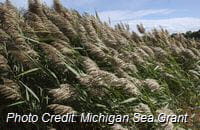FRESHWATER SPONGES IN WASTEWATER TREATMENT PLANT. It’s thought
that, years ago, spawning salmon made their way from Lake Michigan up the
polluted Grand Calumet River, then through a pipe and into the nearly pure water
of an enclosed reservoir in the East Chicago Sanitary District wastewater
treatment plant. Apparently, the salmon brought with them a few strands of
freshwater sponge. A sponge colony developed, subsisting on what little impurities
survived the facility’s new ultraviolet wastewater treatment process.
that, years ago, spawning salmon made their way from Lake Michigan up the
polluted Grand Calumet River, then through a pipe and into the nearly pure water
of an enclosed reservoir in the East Chicago Sanitary District wastewater
treatment plant. Apparently, the salmon brought with them a few strands of
freshwater sponge. A sponge colony developed, subsisting on what little impurities
survived the facility’s new ultraviolet wastewater treatment process.
PET GOLDFISH THROWN INTO HAMILTON, ONTARIO, HARBOR. “It used to be
that goldfish in the Ontario outdoors had a very low survival rate and little success
at reproducing. But officials … say that's been changing in recent years in the
warmer weather we've been experiencing. They've noticed exponential increases
in numbers being counted ... And early this winter [2015-2016], millions of five
centimetre, young-of-the-year goldfish have been seen swimming in giant schools
at various locations in the harbour…”
that goldfish in the Ontario outdoors had a very low survival rate and little success
at reproducing. But officials … say that's been changing in recent years in the
warmer weather we've been experiencing. They've noticed exponential increases
in numbers being counted ... And early this winter [2015-2016], millions of five
centimetre, young-of-the-year goldfish have been seen swimming in giant schools
at various locations in the harbour…”
NATIVE MUSSELS FIND REFUGE IN LAKE ST. CLAIR DELTA. “ ‘Freshwater
mussels are considered the most imperiled group of organisms in North America.
Over 70 percent of them are considered at risk of extinction…’ So reported Dr.
Dave Zanatta… In the case of the Great Lakes, invasive species in the form of
zebra mussels and quagga mussels came close to wiping out native mussels …
Zanatta found that the St. Clair Delta and western Lake Erie ‘were the most
healthy areas of the lakes in terms of native mussel abundances.’ “
mussels are considered the most imperiled group of organisms in North America.
Over 70 percent of them are considered at risk of extinction…’ So reported Dr.
Dave Zanatta… In the case of the Great Lakes, invasive species in the form of
zebra mussels and quagga mussels came close to wiping out native mussels …
Zanatta found that the St. Clair Delta and western Lake Erie ‘were the most
healthy areas of the lakes in terms of native mussel abundances.’ “
http://www.voicenews.com/news/written-off-as-doomed-native-mussels-survive-
zebra-mussel-invasion/article_c44cd58d-e019-5492-92ea-0a39b96b6bb9.html
zebra-mussel-invasion/article_c44cd58d-e019-5492-92ea-0a39b96b6bb9.html
PELICANS COLONIZE POINTE MOUILLEE ON LAKE ERIE. After a long decline,
the North American white pelican population has increased, and the birds are
expanding their range. That includes establishing themselves through the summer
breeding season at Michigan’s Pointe Mouillee State Game Area in the northwest
corner of Lake Erie.
https://www.freep.com/story/news/local/michigan/2018/05/26/pelican-sightings-rise-michigan-lake-erie/637363002/
the North American white pelican population has increased, and the birds are
expanding their range. That includes establishing themselves through the summer
breeding season at Michigan’s Pointe Mouillee State Game Area in the northwest
corner of Lake Erie.
https://www.freep.com/story/news/local/michigan/2018/05/26/pelican-sightings-rise-michigan-lake-erie/637363002/







